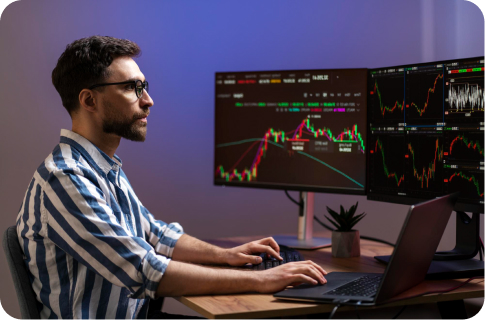


The methods of hedge funds and prop trading firms in generating returns within the financial markets differ significantly. The former primarily serves institutional investors, while the latter is more focused on skilled traders.
Successful hedge funds usually offer about 15% returns after deducting management and performance fees, outperforming the average 8% annual returns from the stock market.
Prop trading firms place a greater emphasis on risk management and individual responsibility; however, they also present higher prospects for significant returns.
Are you contemplating whether to invest in a hedge fund or venture into prop trading? This comparison between these two investment strategies will help you make an informed decision, considering the skill sets necessary for each.
Understanding the differences among various products, tools, and investment channels within the financial market is essential when exploring investment opportunities or planning a career in finance.

Hedge funds are a favored investment strategy among wealthy individuals, pension funds, and institutional investors. When investing in a hedge fund, funds are entrusted to the hedge fund, which then strives to generate profitable returns irrespective of broader market conditions by utilizing a range of complex trading techniques on behalf of its clients.
Proprietary trading, or prop trading, involves a firm providing its own capital to traders to implement trades on its behalf in anticipation of receiving about 10% of any generated profits.
Clearly, hedge funds and prop trading offer substantially different approaches to generating profits within the financial markets. Therefore, it is important to consider your individual needs, financial goals, and risk tolerance when deciding which avenue to pursue.
The world of finance is diverse and multilayered, with different entities playing various roles. Two such entities are hedge funds and proprietary trading firms, both of which have unique characteristics and serve different purposes in the financial markets.
On one hand, we have hedge funds, which are investment vehicles that pool together the capital of accredited or institutional investors, such as pension funds, endowments, insurance companies, and wealthy individuals. Hedge funds are managed by experienced professionals known as hedge fund managers, who employ a wide variety of complex trading techniques and financial instruments to maximize returns. The strategies used by hedge funds can vary greatly – from long/short equity strategies to global macro approaches, depending on the fund’s main objective.

Hedge funds work on behalf of their clientele, who entrust their money with a hope of seeing it grow over time. These entities charge management and performance fees for this service, creating a significant revenue stream. The sophisticated strategies employed by these financial institutions seek to generate profits irrespective of broader market conditions. This is done by using advanced trading tools and methods that can effectively manage risk and take advantage of market volatility.
On the other hand, we have prop trading firms that operate quite differently. In proprietary trading, or “prop trading,” a firm uses its own capital to trade in the financial markets. These trades are executed by prop traders, who are given access to the firm’s capital (often substantial amounts) to start trading.
Unlike hedge funds, prop trading firms do not manage external investors’ money or charge any management fees. Their income is derived solely from the successful trades made using their own accounts. The profits from these trades are usually split between the firm and the trader, usually favoring the prop trading firm in terms of percentage share.
Prop trading is most effective when skilled traders drive it. These traders should be able to navigate international markets efficiently and effectively, even in different situations, in order to make profits for their firms.
Most prop trading firms value active trading techniques and encourage their traders to pursue aggressive strategies that have the potential for high returns, albeit with higher risk.

Unlike hedge funds, which often have long lock-up periods of only a few years for their investors, prop trading firms allow for more flexibility. Prop traders can buy and sell securities on a daily basis, taking advantage of short-term price fluctuations in the financial markets.
Proprietary trading firms and prop trading divisions of large banks face strict regulations from financial authorities. These regulations aim to ensure that risks are appropriately managed and prevent any major losses that could harm the financial system. They also operate under different regulatory standards than hedge funds.

It’s worth noting that while both hedge funds and proprietary trading firms aim to generate profits, they utilize different strategies and cater to different types of clientele. They also differ in terms of how they manage risk and how they handle their own money versus client money.
Both hedge funds and prop trading offer distinct advantages within the financial markets and serve unique roles in the broader financial system. The choice between these two investment strategies ultimately depends on an individual’s or institution’s specific needs, financial goals, tolerance for risk, and expectations for returns.
Hedge funds cater to a diverse range of clientele, which predominantly includes institutional investors such as pension funds and insurance companies. These financial institutions choose to allocate their assets to hedge funds in the hope of diversifying their portfolios and maximizing returns. The clientele of hedge funds also comprises wealthy individuals who possess significant financial resources. These high-net-worth individuals are attracted to hedge funds due to their potential for substantial profits and their reputation for employing sophisticated investment strategies.

The relationship between hedge fund managers and their clients is characterized by the payment of management and performance fees by the clients. Clients invest their money with the hedge fund, entrusting the hedge fund managers with the responsibility of making successful trades in financial markets, leveraging their expertise and access to advanced trading tools. The main objective for these high-profile clients is to achieve consistent returns on their investment while managing risk effectively.
On the contrary, prop trading firms operate on a different business model. Prop trading firms or ‘prop shops’ do not manage money for external investors or clients. Instead, they actively trade using the firm’s capital. Experienced traders appointed by the prop firm take on the risk in the financial markets.
The operational structure of most prop trading firms entails giving their own capital to proficient proprietary traders, or ‘prop traders’ who then use this capital to trade a variety of financial instruments. The prop firm makes money only when these traders execute successful trades. This means that a trader’s performance directly affects how profitable the prop trading firm is.
A unique aspect of prop trading firms is that they do not rely on management or platform fees for revenue generation, unlike hedge funds. This underscores a fundamental difference between how hedge funds work—where they manage money on behalf of external investors—and how prop trading works—where they trade using their own capital.

Both hedge funds and prop trading fulfill unique roles within global financial systems and cater to different sections of market participants. While hedge funds provide an investment vehicle for institutional investors and wealthy individuals looking to maximize their returns, prop trading firms act as platforms for talented traders to start trading using the firm’s capital.
The risk management approach also varies between these two entities – while hedge fund managers must manage the risk associated with a wide variety of investments made on behalf of their clients, prop trading firms must manage the risk associated with their own trading activities in international markets.

Both hedge funds and prop trading firms offer distinct benefits within the financial markets and serve unique roles in a larger financial system. The choice between these two investment strategies ultimately depends on an individual’s or institution’s particular needs, financial goals, tolerance for risk, and expectations for returns. With this understanding, one can make well-informed decisions about where to invest or trade.
Hedge funds are regulated according to the jurisdiction they operate in and typically provide regular disclosures to their investors about how their money is being utilized. From the investor’s perspective, risk management only extends as far as choosing a reputable hedge fund to invest in.

Once an investor’s money is with a hedge fund, all they can do is closely monitor the disclosures released by the hedge fund and ensure that their money isn’t being used recklessly.
The most reputable prop trading firms also stay updated with recent regulations. However, most of the responsibility surrounding risk management in proprietary trading falls squarely on the individual trader.
Prop firms will provide traders with a unique set of in-house risk management rules they must adhere to. Beyond these, the trader should also have their personalized, tried-and-tested risk management techniques.
While the prop trader bears most of the responsibility for risk management, it’s important to acknowledge that the extent of potential risk is reduced because traders are using someone else’s funds instead of risking their own capital.
In the financial markets, hedge funds and prop trading firms represent two distinct yet interconnected facets. They both offer unique pathways to potential profits, but their methods, risks, and rewards differ significantly.
Hedge funds, a preferred investment vehicle for many institutional investors and wealthy individuals, are known for leveraging various financial instruments and trading strategies to generate returns. These sophisticated investment entities aim to yield substantial returns, often targeting a rate close to 15% after accounting for management and performance charges. This figure surpasses the standard 8% annual return traditionally witnessed in stock markets. However, it’s crucial to underscore that this is not a guarantee. Even the most successful hedge funds carry inherent market risks, including the possibility of losing all invested capital.

On the other side of the spectrum are proprietary trading firms or ‘prop firms’. Prop traders at these firms trade with the firm’s capital, their own money essentially, allowing them to retain up to 90% of their successful trades’ profits. With starting equity that can reach $500,000 or more, prop traders have an opportunity to maximize returns far beyond what they could achieve independently. The potent combination of significant starting capital and the ability to keep a large share of profits positions prop traders uniquely within financial markets.
Notably, prop trading involves deploying similar strategies as hedge funds but with a more significant focus on active trading in international markets. It’s worth noting that while both hedge funds and prop shops aim to generate profits from their trades and investments alike, they cater differently to external investors’ needs.
Investors typically select hedge funds as an investment strategy because they rely on experienced traders – or hedge fund managers – who possess deep industry knowledge and market understanding. They trust these hedge fund managers with their money in hopes of achieving higher returns than traditional investment vehicles like mutual funds could offer.

In contrast, prop trading firms or ‘prop shops’ often attract day traders who are confident in their trading skills and eager to start trading with large banks’ capital. These traders are tasked with the challenging job of making profitable trades on behalf of the prop firm, often using advanced trading tools and platforms.
Both hedge funds and prop trading firms serve specific roles within the broader financial system. They offer different strategies for managing risk in financial markets, catering to diverse needs of investors, financial institutions, and individuals with varying levels of risk tolerance and return expectations. Whether you choose to invest in a hedge fund or trade at a prop firm will rely heavily on your personal needs, financial goals, risk tolerance, and expected returns.
To make an informed decision about investing in hedge funds, a comprehensive understanding of the industry and market dynamics is crucial. Investors must consider the reputation and track record of the hedge fund managers who oversee their chosen firm. Successfully navigating the complexities of hedge funds necessitates a well-rounded knowledge base, as these investment vehicles offer a distinct approach to increasing wealth. Additionally, it’s necessary to understand how hedge funds work and the financial instruments they utilize.

Hedge fund managers wield extensive influence over these funds, making strategic decisions that drive performance. Investors place their trust in these managers, expecting them to generate profits that exceed those offered by traditional investment strategies like mutual funds. Due to this expectation, managers often employ different strategies to navigate financial markets and manage risk effectively.
On the other hand, proprietary trading firms require a high level of skill from their prop traders. These traders need an arsenal of abilities including exceptional discipline, patience, market knowledge, and advanced trading skills. In essence, prop traders dictate their own fate within the trading world.
Prop trading firms entrust large amounts of their own capital to these traders who then execute trades on international markets using advanced trading tools and platforms. The job security for prop traders lies in their ability to consistently make successful trades on behalf of the proprietary trading firms they represent.
Proprietary trading places more emphasis on individual risk and responsibility compared to hedge funds. However, this also means that prop traders have the potential for higher returns if they successfully navigate market volatility and turn profits from their trading activity. Additionally, algorithmic prop trading has become increasingly prevalent, with prop trading firms utilizing algorithms to automate trading based on predefined criteria.
Whether one chooses to invest in hedge funds or join a prop trading firm depends largely on their own personal objectives and risk tolerance levels. Proprietary trading firms typically appeal to those who are confident enough in their abilities to use large banks’ capital for active trading on international markets. Hedge funds tend to attract investors seeking a less hands-on approach but still desiring substantial returns.

While both hedge funds and prop trading firms play crucial roles within the broader financial system, they each cater to unique needs. They offer different strategies for managing risk in financial markets, appealing to a diverse array of investors, financial institutions, and individuals with varying levels of risk tolerance and return expectations. Ultimately, the decision between investing in a hedge fund or joining a prop trading firm will heavily rely on personal needs, financial goals, risk tolerance, and expected returns. The main objective remains the same: to maximize returns and manage risk effectively.
When considering hedge funds or prop trading firms, personal objectives and risk tolerance are key. Hedge funds, steered by seasoned hedge fund managers, offer a more subdued investment vehicle for those opting out of active trading with their own capital. Modest returns are the norm for hedge funds; however, prop traders often see more substantial profits.

Prop trading firms demand an elevated level of commitment from traders and provide proprietary trading opportunities within financial markets using the firm’s capital. The thrill of active trading attracts confident individuals eager to utilize large banks’ capital in international markets. They employ diverse strategies and financial instruments to adeptly navigate market volatility.
Conversely, hedge funds draw conservative investors seeking a hands-off approach with significant returns. These funds, managed by professional hedge fund managers, employ similar strategies in financial markets but typically carry less risk than prop trading. They serve as an investment avenue for wealthy individuals, financial institutions, and institutional investors.
The decision between investing in a hedge fund and joining a prop trading firm will largely depend on personal needs, financial goals, risk tolerance levels, and anticipated returns. Both offer varying approaches to investment strategies aimed at generating profits in the financial markets with efficient risk management.
Regardless of whether one invests in hedge funds or joins prop trading firms, it’s essential to remember that both aim for successful trades with the same primary objective: managing risk effectively while maximizing returns.